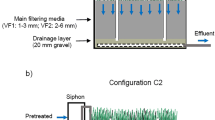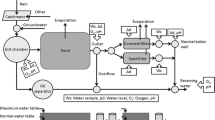Abstract
Centrifugal filters commonly used in irrigation systems are able to separate coarse-grained sediments larger than 100 μm. Improving the filter structural characteristics and separation efficiency of fine-grained sediment has become an issue that needs to be solved. Therefore, a combination of experiment and numerical simulation was used to assess the effect of volute optimized design and semi-closed inlets on centrifugal filter separation efficiency and energy consumption. The results show that balancing the relationship between the separation efficiency and head loss, the improvement of the filter structure optimizes its internal flow field, and the filter head loss can be appropriately increased to greatly improve the separation efficiency of fine sediment. Compared with a conventional centrifugal filter, the volute optimized centrifugal filter synergistically improved the fine particle separation efficiency (22.83–123.19%) and reduced the head loss (39.06–45.98%), while the semi-closed inlet improved the separation efficiency of particle diameters above 30 μm by 14.29–60.56% and increased the head loss (18.73–28.16%). The combination of the two previous improvements and the reduction of the filter volume further improved the separation efficiency (21.99–65.10%) but gradually increased the head loss. This study provides a new perspective for improved centrifugal filters with an efficient, broadly applicable experimental design for studying the potential implications for highly Turbidity water utilization in irrigation.








Similar content being viewed by others
References
Adin A, Alon G (1986) Mechanisms and process parameters of filter screens. J Irrig Drain Eng 112(4):293–304
Bové J, Puig-Bargués J, Arbat G et al (2017) Development of a new underdrain for improving the efficiency of micro irrigation sand media filters. Agric Water Manag 179:296–305
Capra A, Scicolone B (2004) Emitter and filter tests for wastewater reuse by drip irrigation. Agric Water Manag 68(2):135–149
Chiné B, Concha F (2000) Flow pattern in conical and cylindrical hydrocyclones. Chem Eng J 80(1–3):267–273
Duran-Ros M, Puig-Brgues J, Arbat G (2009) Performance and backwashing efficiency of disc and screen filters in micro-irrigation systems. Biosyst Eng 103(1):35–42
Han SQ, Li YK, Xu FP et al (2018) Effect of lateral flushing on emitter clogging under drip irrigation with yellow river water and a suitable method. Irrig Drain 67(2):199–209
Juanico M, Azov Y, Teltsch B (1995) Effect of effluent addition to a freshwater reservoir on the filter clogging capacity of irrigation water. Water Res 29(07):1695–1702
Li YK, Song P, Pei YT et al (2015) Effects of lateral flushing on emitter clogging and biofilm components in drip irrigation systems with reclaimed water. Irrig Sci 33(3):235–245
Liu Y, Yang Q, Qian P et al (2014) Experimental study of circulation flow in a light dispersion hydrocyclone Science Direct. Sep Purif Technol 137:66–73
Lv WJ, Huang C, Chen JQ et al (2015) An experimental study of flow distribution and separation performance in a UU-type mini-hydrocyclone group. Sep Purif Technol 150:37–43
Neesse T, Dueck J, Schwemmer H et al (2015) Using a high pressure hydrocyclone for solids classification in the submicron range. Miner Eng 71:85–88
Noroozi S, Hashemabadi SH (2009) CFD simulation of inlet design effect on deoiling hydrocyclone separation efficiency. Chem Eng Technol 32(12):1885–1893
Patra G, Velpuri B, Chakraborty S et al (2017) Performance evaluation of a hydrocyclone with a spiral rib for separation of particles. Adv Powder Technol 28(12):3222–3232
Puig-Bargués J, Lamm FR (2013) Effect of flushing velocity and flushing duration on sediment transport in micro irrigation driplines. Trans ASABE 56:1821–1828
Puig-Bargués J, Barragán J, Cartagena FRD (2005) Development of equations for calculating the head loss in effluent filtration in microirrigation systems using dimensional analysis. Biosys Eng 92(3):383–390
Qi YX (2014) Experimental study on the treatment effect of gravity sedimentation filter pool of river drip irrigation on river cement sand. China Rural Water Hydropower 4:15–17
Qian P, Ma J, Liu Y et al (2016) Concentration distribution of droplets in a liquid–liquid hydrocyclone and its application. Chem Eng Technol 39(5):953–959
Skaggs R (2000) Drip irrigation in the desert: adoption, implications, and obstacles. General Inf 25(2):716–716
Solé-Torres C, Puig-Bargués J, Duran-Ros M et al (2019) Effect of different sand filter underdrain designs on emitter clogging using reclaimed effluents. Agric Water Manag 223(20):105683
Svarovsky L (2000) Solid-liquid separation, 4th edn. Butterworth-Heinemann, Oxford
Tang B, Xu Y, Song X et al (2015) Nμmerical study on the relationship between high sharpness and configurations of the vortex finder of a hydrocyclone by central composite design. Chem Eng J 278:504–516
Tao HF, Yang HH, Ma YJ et al (2017) Influence of flow rate on flow velocity distribution in gravity sinking and filter tank for drip irrigation with river water. Trans Chin Soc Agric Eng 33(1):131–137
Vakamalla TR, Kμmbhar KS, Gujjula R et al (2014) Computational and experimental study of the effect of inclination on hydrocyclone performance. Sep Purif Technol 138:104–117
Vieira LGM, Silva DO, Barrozo MAS (2016) Effect of inlet diameter on the performance of a filtering hydrocyclone separator. Chem Eng Technol 39(8):1406–1412
Wang HL (2019) Advanced hydrocyclone technology for liquid-solid separation. Chemical Industry Press, Beijing
Williamson RD, Rott TR, Kumar HS et al (1983) Use of hydrocyclones for small particle separation. Sep Sci Technol 18(12–13):1395–1416
Yang AQ, Li ZM, Lv WJ et al (2013) On the laboratory and field studies of removing fine particles suspended in wastewater using mini-hydrocyclone. Sep Purif Technol 110(23):93–100
Yu JF, Fu J, Cheng H et al (2017) Recycling of rare earth particle by mini-hydrocyclones. Waste Manag 61:362–371
Yurdem H, Demir V, Degirmencioglu A (2010) Development of a mathematical model to predict clean water head losses in hydrocyclone filters in drip irrigation systems using dimensional analysis. Biosyst Eng 105(4):495–506
Zhang WB, Li CM, Cao F (2015) Effect evaluation on sediment treatment of drip irrigation project for the yellow river water. Trans Chin Soc Agric Eng 5(4):107–109
Zhou B, Hou P, Xiao Y et al (2021) Visualizing, quantifying, and controlling local hydrodynamic effects on biofilm accumulation in complex flow paths. J Hazard Mater 416(1):125937
Acknowledgements
The authors are grateful for the financial support from the National Natural Science Foundation of China (51790531) and National Key Research Project of China (2017YFD0201504).
Author information
Authors and Affiliations
Corresponding author
Ethics declarations
Conflict of interest
On behalf of all authors, the corresponding author states that there is no conflict of interest.
Additional information
Publisher's Note
Springer Nature remains neutral with regard to jurisdictional claims in published maps and institutional affiliations.
Supplementary Information
Below is the link to the electronic supplementary material.
Rights and permissions
About this article
Cite this article
Hou, P., Puig-Bargués, J., Xiao, Y. et al. An improved design of irrigation centrifugal filter for separating water and fine sediment: appropriately increase head loss for high efficiency. Irrig Sci 40, 151–161 (2022). https://doi.org/10.1007/s00271-021-00765-9
Received:
Accepted:
Published:
Issue Date:
DOI: https://doi.org/10.1007/s00271-021-00765-9




